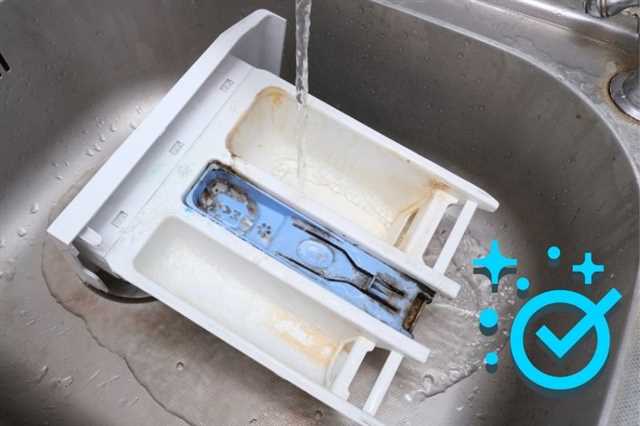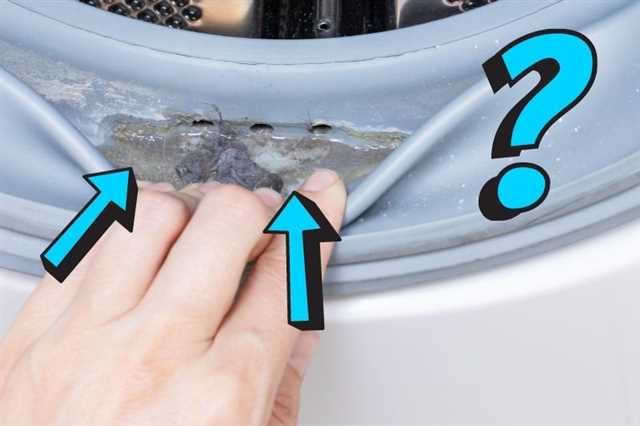
If you have noticed an unpleasant grey sludge on your clothes after doing a load of laundry, you are not alone. Many people have experienced this frustrating issue, but fortunately, there are solutions to tackle the problem. In this article, we will explore the causes of the grey sludge and provide suggestions on how to prevent it from ruining your laundry.
One of the main causes of the grey sludge is the buildup of residue inside the washing machine. Over time, detergent, fabric softener, and dirt can accumulate in the drum and on the interior surfaces of the machine. This residue can then transfer onto your clothes during the wash cycle, leaving behind the grey sludge.
To avoid this issue, it is recommended to clean the washing machine regularly. You can do this by running an empty cycle with hot water and a cup of vinegar. This will help to remove any buildup and kill any bacteria or mildew that may be causing the grey sludge. Additionally, you can detach and clean the detergent drawer and gasket to ensure that no residue is left behind.
In terms of laundry care, there are a couple of suggestions that can help prevent the grey sludge from appearing on your clothes. First, make sure to check the dosages of detergent and fabric softener that you are using. Using too much detergent or softener can contribute to the buildup of residue. Additionally, try to avoid overloading the washing machine as this can prevent clothes from being properly agitated and cleaned.
In some cases, the grey sludge may be more resistant and require further steps to remove. If this is the case, you can try using a specialized washing machine cleaner. These cleaners are designed to penetrate and eliminate the residues that normal wash cycles might miss. Simply follow the instructions on the product packaging for best results.
By following these tips and regularly cleaning your washing machine, you will be able to prevent the occurrence of the grey sludge on your clothes. Not only will your laundry look and smell fresher, but you will also extend the lifespan of your clothes.
- What Causes Grey Sludge on Clothes
- Effects of Grey Sludge on Clothes
- Stains and Marks
- Stiffness and Discomfort
- Unpleasant Odors
- Potential Health Risks
- How to Remove Grey Sludge from Clothes
- Preventing Grey Sludge on Clothes
- 1. Use the right amount of detergent
- 2. Sort clothes properly
- 3. Clean the washing machine regularly
- 4. Check for foreign objects
- 5. Use the right water temperature
- 6. Use the appropriate washing mode
- 7. Add vinegar to the wash cycle
- 8. Use eco-friendly options
- How to Clean Hotpoint Washing Machine
- 1. Clean the drum and seal
- 2. Clean the filter
- 3. Clean the detergent drawer
- 4. Clean the exterior
- Conclusion
- Video:
- Washing Machine – Laundry Room Smell / Odor
What Causes Grey Sludge on Clothes
Grey sludge on clothes is a common issue that can occur when using a washing machine. There are several potential causes for this problem, including the following:
- Poor detergent dispersion: When using too much detergent or not dissolving it properly before adding clothes to the washing machine, it can lead to grey sludge. To ensure proper dispersion, always follow the dosage instructions on the detergent packaging and dissolve it in water before adding it to the machine.
- Using the wrong detergent: Certain detergents may not be suitable for all types of fabrics, causing a grey residue. Make sure to use a detergent that is appropriate for the specific type of clothing you are washing, especially for delicates.
- Inadequate cleaning of the washing machine: Over time, residue from dirt, soap scum, and fabric fibers can accumulate in the washing machine. This buildup can transfer onto clothes during the wash cycle, resulting in grey sludge. Regularly clean the washing machine to prevent this issue. Refer to the manufacturer’s manual for guidelines on how to clean your specific machine.
- Using the wrong washing cycle: Different fabrics and types of clothing require specific washing cycles. Using the wrong cycle, such as washing delicate fabrics with heavy-duty cycles, can cause grey sludge. Select the appropriate cycle for the type of clothing being washed.
- Hard water: If your water supply has high mineral content, it can leave deposits on clothes, giving them a grey appearance. Consider using a water softener or adding vinegar to the wash to help combat this issue.
- Excessive running time: Running the washing machine for too long can lead to grey sludge on clothes. Avoid unnecessarily long wash cycles and check the timer to ensure that the machine is not running longer than necessary.
- Issues with the machine: Problems with the washing machine itself, such as clogged hoses or issues with the water distribution system, can cause grey sludge on clothes. If you suspect that the machine is the source of the problem, contact a professional for repairs.
- Leftover items in pockets: Coins, paper tissues, or other items left in pockets can disintegrate during the wash cycle and create grey sludge. Always check pockets before loading clothes into the washing machine.
If you are experiencing grey sludge on your clothes, try addressing these potential causes one by one to find the source of the issue. By taking the necessary precautions and following the appropriate washing guidelines, you can ensure that your clothes come out clean and free of grey sludge.
Effects of Grey Sludge on Clothes
When grey sludge is present on clothes after they have been washed, it can have several negative effects. Not only does it leave unsightly stains and marks, but it can also make the clothes feel stiff and uncomfortable to wear. Additionally, the grey sludge may contain bacteria, mold, or other contaminants that can lead to unpleasant odors and potential health risks.
Stains and Marks
The dried grey sludge on clothes provides an unattractive appearance, often leaving visible stains and marks. These stains can be particularly noticeable on light-colored or white garments, making them appear dirty and grungy, even after being washed.
Stiffness and Discomfort

The presence of grey sludge can make clothes feel stiff and rough to the touch. This can result in reduced comfort and make it less enjoyable to wear the affected garments. Moreover, the sludge residue can also cause irritation to sensitive skin, leading to discomfort and potential skin problems.
Unpleasant Odors
Grey sludge may contain bacteria, mold, and other contaminants that can produce unpleasant odors. These odors can persist even after the clothes have been washed, and they may become more noticeable when the clothes are worn or exposed to heat or humidity.
Potential Health Risks

If the grey sludge on clothes contains harmful bacteria or mold, it can pose health risks. Breathing in or coming into contact with these contaminants can lead to respiratory issues, allergies, or other health problems. It is important to take proper measures to prevent and remove grey sludge to maintain a healthy living environment.
In conclusion, the effects of grey sludge on clothes range from visual dissatisfaction to discomfort and potential health risks. Therefore, it is advisable to follow proper maintenance and cleaning practices for the washer and washer-dryer to prevent the formation of grey sludge and ensure clean and fresh-smelling clothes.
How to Remove Grey Sludge from Clothes
Dealing with grey sludge on clothes from the washing machine can be frustrating, but there are steps you can take to remove it effectively. Here are some tips and tricks to help you get rid of that unwanted grey sludge:
- Thoroughly clean the washer: Start by cleaning the washing machine itself to ensure there is no build-up of dirt or gunk. Detach and clean the filter, remove any coins or small objects, and clean all surfaces of the drum and pump.
- Choose the right detergent: Certain detergents may contribute to the formation of grey sludge. Use detergents recommended for your washer and avoid using too much detergent.
- Check water pressure: Low water pressure can prevent the washer from fully rinsing out the detergent, leading to the formation of grey sludge. Ensure that the water pressure is sufficient for proper cleaning.
- Use hot water: Washing clothes in hot water can help dissolve detergent residue and remove sludge effectively. Check the clothing labels to ensure that hot water is safe for the fabrics.
- Choose the right wash setting: Select a wash setting that is appropriate for the clothes you are washing. For heavily soiled items, choose a longer wash cycle to enable better cleaning.
- Reduce the load size: Overloading the washer can prevent proper agitating and cleaning. Ensure that you do not exceed the recommended load size for your washer.
- Separate whites from colored clothes: Washing white clothes separately can help prevent color transfer and reduce the formation of grey sludge.
- Perform regular maintenance: Regularly clean the washer and dryer as per the manufacturer’s instructions. This will help prevent the build-up of dirt, mold, and other allergens.
By following these steps, you can effectively remove grey sludge from your clothes and ensure that they come out clean and fresh from the washer.
Preventing Grey Sludge on Clothes
Grey sludge on clothes can be a frustrating issue that many people face when using a washing machine. However, there are several preventive measures that can be taken to avoid this problem.
1. Use the right amount of detergent
Using too much detergent can lead to the formation of grey sludge. It is important to use the recommended amount of detergent based on the water hardness and clothing load level. Read the detergent packaging for guidance and adjust accordingly.
2. Sort clothes properly
Sorting clothes before washing is crucial to prevent the transfer of color and dirt. Separating dark, colored, and light-colored clothes will ensure that dirt and lint from one garment do not end up on another.
3. Clean the washing machine regularly
A clean washing machine is less likely to produce grey sludge. Regularly clean the drum, detergent drawer, and filter. Follow the manufacturer’s instructions for cleaning the machine, as different models may require different cleaning methods.
4. Check for foreign objects

Before starting the wash, ensure that there are no coins, small objects, or detachable parts in the pockets of your clothes. These objects can cause damage to the drum and increase the risk of grey sludge.
5. Use the right water temperature
Using hot water for washing whites and cold water for synthetic fabrics can help prevent grey sludge. Hot water helps remove dirt and stains more effectively, while cold water is gentler on delicate fabrics.
6. Use the appropriate washing mode

Choose the washing mode that is most suitable for your clothes to ensure proper cleaning. Avoid using a mode that is too short or too long for the clothing load. Consult the washing machine manual for guidance on which mode to select.
7. Add vinegar to the wash cycle
Adding a cup of vinegar to the wash cycle can help remove dirt and residue from clothes. Vinegar acts as a natural fabric softener and helps prevent the formation of grey sludge.
8. Use eco-friendly options
Using eco-friendly detergents and washing machine settings can help minimize the risk of grey sludge. These options are designed to be more environmentally friendly and can be less harsh on fabrics.
| Preventive Measures | Benefits |
|---|---|
| Use the right amount of detergent | – Prevents detergent residue buildup |
| Sort clothes properly | – Avoids color and dirt transfer |
| Clean the washing machine regularly | – Reduces the risk of sludge formation |
| Check for foreign objects | – Prevents damage to the drum |
| Use the right water temperature | – Ensures effective cleaning |
| Use the appropriate washing mode | – Tailored cleaning for different clothes |
| Add vinegar to the wash cycle | – Acts as a natural fabric softener |
| Use eco-friendly options | – Reduces harshness on fabrics |
How to Clean Hotpoint Washing Machine
If you are a Hotpoint washing machine user, it is important to know how to clean your machine regularly to ensure that it is able to perform at its best and keep your clothes clean. In this article, we will provide you with information on how to clean your Hotpoint washing machine in a way that is effective and easy to follow.
1. Clean the drum and seal
- Start by cleaning the drum and seal of your washing machine. These areas are prone to build-up of dirt, particles, and odours.
- Insert a clean cloth or towel into the drum and seal to collect any loose particles or dirt.
- Run a wash cycle without any clothing or laundry detergent. You can use a small quantity of white vinegar instead to help eliminate odours.
2. Clean the filter
- Locate the filter of your Hotpoint washing machine. The location may vary depending on the model, so refer to the manufacturer’s manual for specific instructions.
- Make sure the machine is switched off and unplugged before you start the cleaning procedure.
- Carefully remove the filter and rinse it under running water to remove any debris or build-up. You can use a soft brush to remove any stubborn dirt.
- Once the filter is clean, place it back into its original position and make sure it is locked securely.
3. Clean the detergent drawer
- Remove the detergent drawer from your Hotpoint washing machine.
- Wash the drawer under running water to remove any soap residue or build-up.
- Use a soft brush or cloth to clean the inside of the drawer, paying attention to any hard-to-reach areas.
- Make sure the drawer is completely dry before reinserting it into the machine.
4. Clean the exterior
- Wipe the outside of your Hotpoint washing machine with a damp cloth to remove any dirt or dust.
- If there are any tough stains or marks, you can use a mild detergent solution to clean them.
- Make sure to dry the exterior of the machine thoroughly before using it again.
Conclusion
By following these simple steps, you can ensure that your Hotpoint washing machine stays clean and functions properly. Regular cleaning will not only help to avoid the build-up of dirt and odours but will also extend the life of your machine. Remember to consult your manufacturer’s manual for any specific instructions and to always refer to their recommended cleaning procedures. Taking care of your washing machine will guarantee that you get the best value and long-lasting performance out of it!








